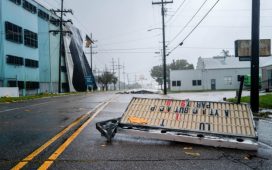Unlock the Editor’s Digest for free
Roula Khalaf, Editor of the FT, selects her favourite stories in this weekly newsletter.
“We have no choice,” said Axa’s then boss Henri de Castries in 2015, as the French insurer announced plans to shun investments in coal companies. “A 2C world might be insurable, a 4C world certainly would not be.”
If anything, that looks optimistic. As the world grapples to keep the Paris targets for limiting rises in global temperature in sight, it is already experiencing more extreme weather patterns and more extreme insurance losses.
California last month struck a deal with insurance companies to continue writing policies for property in disaster-prone areas, after big US names such as State Farm and Allstate stopped issuing any new cover there. Multiple insurers have failed or pulled out of states including Florida and Louisiana, where premiums have already soared. Nor is this just a US phenomenon. About one in seven Australian properties in high-risk areas is expected to be uninsurable this decade, with prices soaring in Queensland and New South Wales after the 2022 floods.
For climate scientist Michael Mann, the ability to cover the effects of climate change is being tested sooner than expected. “Climate models have likely underpredicted the impact of climate change on the sorts of persistent weather extremes behind the devastating wildfires, floods and heatwaves we’ve seen in recent summers,” he says. The unpredictable path of climate change is a particular problem for insurers that cling to historical data like a comfort blanket. As the Bank of England puts it, “Historic data sets are not likely to be a good predictor of how climate risks may affect firms’ future losses.” Insured losses for natural catastrophes were 54 per cent above their 10-year average in the first half of 2023, according to Swiss Re.
The result is that the insurance world seems to be flirting with the kind of doom loop that climate campaigners fear, where the need to manage the fallout from climate change distracts from the underlying problem.
One aspect of this is self-defeating behaviour. Research by Ceres, based on 2019 data, found the largest US insurers were still substantial and influential holders of fossil-fuel assets. As the costs of climate change are pushed on to consumers through premiums and taxpayers through public provision or backstops, it makes little sense not to tighten restrictions on where insurers are investing and requirements for green transition plans for underwriting. This is especially true as collective action by the sector on carbon emissions has crumbled under US political pressure.
Measures that obscure the appropriate pricing of climate risk also contribute to a vicious circle. California’s agreement, which allows prices to rise as insurers incorporate forward-looking modelling and reinsurance costs into rate setting, is progress. But the political instinct to use publicly funded alternatives to plug gaps — whether in US federal flood insurance, Florida’s state safety net or the UK’s Flood Re — tends to depress prices that should send a red alert to those building in or moving to high-risk areas. The continued growth of high-risk, high-value areas is another factor behind mounting losses.
Insurers and governments should instead put more emphasis on changes and behaviour that reduce risk. “Society, including insurance companies, has globally not been strict enough on prevention,” says Frédéric de Courtois, deputy chief executive officer of Axa.
This includes looking at how nature-based adaptations such as better forest management or the restoration of salt marshes can reduce wildfire or flood risk, argues Dave Jones, a former California insurance commissioner. Insurers, he says, should have to incorporate the proven impact of ecological forestry in premiums. Lack of data can be an issue. UK insurer Aviva this week announced a Lancashire research project on salt marshes, coastal wetland shown to cut property-related damages in the US from Hurricane Sandy.
The implications of uninsurability have caught the attention of financial regulators, who previously viewed climate losses in the financial sector as the key issue for stability. Australia’s prudential regulator made one of its key supervision priorities this year the “availability, affordability and sustainability” of insurance. The European Central Bank has expressed concern that only a quarter of EU climate-related catastrophe losses are insured, given the potential “macroeconomic, financial and fiscal impacts”.
“Uninsurability is the first stage of uninhabitability,” Mann has said for many years. It must be managed in a way that mitigates rather than exacerbates the underlying risks.











